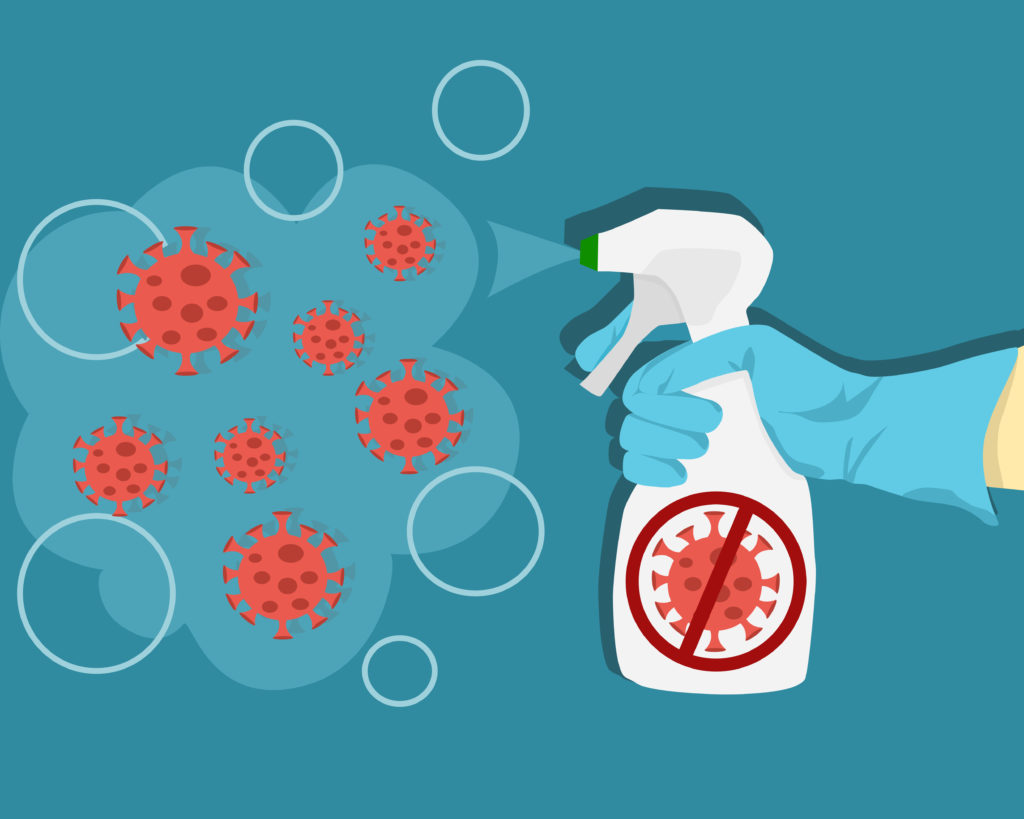
Some steps to take if COVID-19 appears in your auto body shop
By onAssociations | Business Practices | Education | Legal | Repair Operations
The COVID-19 coronavirus has demanded collision repairers practice proper sanitization and take other precautions to protect themselves and their customers from the threat in the abstract.
But what do you when the disease is confirmed to have visited your auto body shop, borne by an employee, customer, insurer or vendor?
It could happen despite your best efforts. It has happened to at least one of your colleagues. Alliance of Automotive Service Providers of New Jersey Executive Director Charles Bryant on Thursday confirmed advising a repairer with an employee who had tested positive for COVID-19. Bryant said the shop wished to remain anonymous for the purposes of this article.
The Centers for Disease Control has issued guidance for companies who’ve had contact with a confirmed COVID-19 case. The U.S. Equal Employment Opportunity Commission and CDC also have discussed how businesses should manage the disease without compromising the rights of current staff or job candidates. Here’s some highlights and other information worth considering.
Talking to the employee
“First, when the employee brings you the news, express sympathy,” executive coach Alisa Cohn wrote in the Harvard Business Review on March 30. (Emphasis hers.) “Even if the person’s symptoms are mild, they are likely to be anxious about what might happen or whether they might have spread the virus to their family or coworkers. Let the employee share their feelings. As you talk with them, clearly communicate that they can count on you and the team to be supportive. You could say, for example: ‘I know that this is a scary thing to deal with. I am here for you if you need to talk, and certainly I understand that you may not be able to work for a little while or that your productivity may go down. Don’t worry about that, I understand what you’re dealing with.'”
A March 21 EEOC publication also discusses a company’s interactions with employees who could potentially be carrying COVID-19:
6. During a pandemic, how much information may an ADA-covered employer request from employees who report feeling ill at work or who call in sick?
ADA-covered employers may ask such employees if they are experiencing influenza-like symptoms, such as fever or chills and a cough or sore throat. Employers must maintain all information about employee illness as a confidential medical record in compliance with the ADA.
If pandemic influenza is like seasonal influenza or spring/summer 2009 H1N1, these inquiries are not disability-related. If pandemic influenza becomes severe, the inquiries, even if disability-related, are justified by a reasonable belief based on objective evidence that the severe form of pandemic influenza poses a direct threat.
Applying this principle to current CDC guidance on COVID-19, employers may ask employees who report feeling ill at work, or who call in sick, questions about their symptoms to determine if they have or may have COVID-19. Currently these symptoms include, for example, fever, chills, cough, shortness of breath, or sore throat.
7. During a pandemic, may an ADA-covered employer take its employees’ temperatures to determine whether they have a fever?
Generally, measuring an employee’s body temperature is a medical examination. If pandemic influenza symptoms become more severe than the seasonal flu or the H1N1 virus in the spring/summer of 2009, or if pandemic influenza becomes widespread in the community as assessed by state or local health authorities or the CDC, then employers may measure employees’ body temperature.
However, employers should be aware that some people with influenza, including the 2009 H1N1 virus or COVID-19, do not have a fever.
Because the CDC and state/local health authorities have acknowledged community spread of COVID-19 and issued attendant precautions as of March 2020, employers may measure employees’ body temperature. As with all medical information, the fact that an employee had a fever or other symptoms would be subject to ADA confidentiality requirements.
8. When an employee returns from travel during a pandemic, must an employer wait until the employee develops influenza symptoms to ask questions about exposure to pandemic influenza during the trip?
No. These would not be disability-related inquiries. If the CDC or state or local public health officials recommend that people who visit specified locations remain at home for several days until it is clear they do not have pandemic influenza symptoms, an employer may ask whether employees are returning from these locations, even if the travel was personal.(31)
Similarly, with respect to the current COVID-19 pandemic, employers may follow the advice of the CDC and state/local public health authorities regarding information needed to permit an employee’s return to the workplace after visiting a specified location, whether for business or personal reasons.
Talking to other employees
“If an employee is confirmed to have COVID-19 infection, employers should inform fellow employees of their possible exposure to COVID-19 in the workplace but maintain confidentiality as required by the Americans with Disabilities Act (ADA),” the CDC states. “The fellow employees should then self-monitor for symptoms (i.e., fever, cough, or shortness of breath).”
Joseph J. Lazzarotti wrote in the National Law Review on March 17 that “EEOC’s ADA regulation 1630.14(d)(4)(i) says that any medical information regarding the medical condition of an employee shall be treated as a confidential medical record.”
Cohn in HBR said an employer can’t disclose who’d tested positive. She appeared to be referencing March 24 advice by the law firm Littler Mendelson. (“Employers should not, however, disclose to co-workers the identity of the quarantined employee because confidentiality requirements under federal law, such as the Americans with Disabilities Act (ADA), or state law, such as California’s Confidentiality of Medical Information Act (CMIA), may apply.”)
Cohn in the HBR article advised using a message like: “Someone in our workplace has tested positive for Covid-19, and they have identified you as a close contact according to the CDC definition. We are here to support you. If you are at work, please prepare to leave as quickly as you can. Once you get home — or if you are already working from there — find a place to self-isolate, monitor yourself for any symptoms, and talk to your doctors. How can I support you in doing all this?”
The CDC defines “close contact” as “being within approximately 6 feet (2 meters) of a COVID-19 case for a prolonged period of time; close contact can occur while caring for, living with, visiting, or sharing a health care waiting area or room with a COVID-19 case” or “having direct contact with infectious secretions of a COVID-19 case (e.g., being coughed on).”
Worker should stay home
An employee with COVID-19 or who might have it should stay home, according to the CDC.
“Employees who have symptoms (i.e., fever, cough, or shortness of breath) should notify their supervisor and stay home,” the agency states.
It said those workers “should follow CDC-recommended steps. Employees should not return to work until the criteria to discontinue home isolation are met, in consultation with healthcare providers and state and local health departments.”
“Most people with COVID-19 have mild illness and are able to recover at home without medical care,” the CDC advises patients. “Do not leave your home, except to get medical care. Do not visit public areas.”
Under a new law, that employee can claim two weeks of paid sick leave at up to $511 a day for COVID-19 reasons even if a company doesn’t offer the benefit normally. The government will immediately reimburse it by allowing the body shop to hang on to an equivalent amount of money instead of depositing it for payroll tax. (Find out more about the new sick and family leave rules for businesses here.)
“For purposes of the FFCRA, the regular rate of pay used to calculate your paid leave is the average of your regular rate over a period of up to six months prior to the date on which you take leave.[2],” the Department of Labor explained in a FAQ. “If you have not worked for your current employer for six months, the regular rate used to calculate your paid leave is the average of your regular rate of pay for each week you have worked for your current employer.
“If you are paid with commissions, tips, or piece rates, these amounts will be incorporated into the above calculation to the same extent they are included in the calculation of the regular rate under the FLSA.
“You can also compute this amount for each employee by adding all compensation that is part of the regular rate over the above period and divide that sum by all hours actually worked in the same period.”
Clean, air out facility
According to the CDC, the business must take precautions on top of the regular cleaning and sanitization best practices for the pandemic:
• At a school, daycare center, office, or other facility that does not house people overnight:
° Close off areas visited by the ill persons. Open outside doors and windows and use ventilating fans to increase air circulation in the area. Wait 24 hours or as long as practical before beginning cleaning and disinfection.
° Cleaning staff should clean and disinfect all areas such as offices, bathrooms, common areas, shared electronic equipment like tablets, touch screens, keyboards, remote controls, and ATM machines used by the ill persons, focusing especially on frequently touched surfaces. …
• If it has been more than 7 days since the person with suspected/confirmed COVID-19 visited or used the facility, additional cleaning and disinfection is not necessary. (Minor formatting edits.)
The CDC recommends disinfecting using chemicals on this Environmental Protection Agency list.
In other cleaning news, Edmunds on March 13 offered an interesting reminder of a place you might have missed on a customer’s vehicle.
You’ll want to clean the places you come into contact with the most. Besides the obvious places such as a door handle, key fob or steering wheel, the most important part of the interior to keep clean is the dashboard, according to Charles P. Gerba, a professor of microbiology and public health at the University of Arizona. “That’s the worst site in terms of total number of bacteria,” Gerba said. “Air is constantly being sucked over and circulated inside the car.”
More information:
COVID-19: “What to Do if You Are Sick”
Centers for Disease Control, March 25, 2020
“Cleaning and Disinfecting Your Facility”
CDC, April 1, 2020
“List N: Disinfectants for Use Against SARS-CoV-2”
Environmental Protection Agency, April 2, 2020
“Cleaning and Disinfection for Community Facilities” (includes businesses)
CDC, April 1, 2020
CDC, March 21, 2020
“Discontinuation of Home Isolation for Persons with COVID-19 (Interim Guidance)”
CDC, March 16, 2020
“Your Employee Tested Positive for Covid-19. What Do You Do?”
Alisa Cohn in Harvard Business Review, March 30, 2020
“HIPAA Privacy Rule Waiver, Other Medical Information Questions During the COVID-19 Pandemic”
Joseph J. Lazzarotti in National Law Review, March 17, 2020
“PANDEMIC PREPAREDNESS IN THE WORKPLACE AND THE AMERICANS WITH DISABILITIES ACT”
Equal Employment Opportunity Commission, March 21, 2020
“What You Should Know About the ADA, the Rehabilitation Act, and COVID-19”
EEOC, March 19, 2020
Images:
You should disinfect your facility with a chemical from the EPA’s List N, according to the CDC. (Joanna Skoczen/iStock)
A transmission electron microscope view of SARS-CoV-2, the virus causing COVID-19, emerging from cells. (National Institute of Allergy and Infectious Diseases-Rocky Mountain Laboratories https://creativecommons.org/licenses/by/2.0/legalcode)

